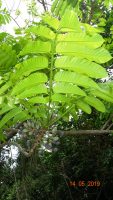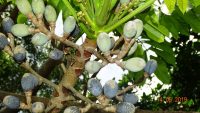Canarium euphyllum Kurz, J. Asiat. Soc. Bengal, Pt. 2, Nat. Hist. 41: 295 (1872) ;
.
Bangladesh to Indo-China: Andaman Is., Bangladesh, Myanmar, Nicobar Is., Thailand as per POWO;
.



Sharing images of Canarium euphyllum Kurz (Burseraceae): 3 images.
Canarium euphyllum Kurz (Burseraceae) is distributed in the Andaman and Nicobar Islands, India, Bangladesh, Myanmar and Thailand.
Tall trees are frequent in the interior forests of Andaman Islands and they yield commercial “dhup”.
The present photographs were shot by Dr. M.C. Naik from Andaman Islands.
.
References:
POWO Catalogue of Life GBIF (High resolution specimens) India Biodiversity Portal FRLHT Useful Tropical Plants iNaturalist
Dispersal of Canarium euphyllum (Burseraceae), a large-seeded tree species, in a moist evergreen forest in Thailand (We investigated the dispersal of a large-seeded tree species, Canarium euphyllum (Burseraceae), in the moist evergreen forests of the Khao Yai National Park in Thailand. By combining direct observations of fruit consumption in tree canopies (543 h) and the camera-trapping observations of fallen fruit consumption on the forest floor (175 camera-days), we identified the frugivore assemblage that foraged on the fruits of C. euphyllum and assessed their role in seed dispersal and seed predation. In the canopy, our results showed that seeds were dispersed by a limited set of frugivores, one pigeon and four hornbill species, and predated by two species of squirrel. On the forest floor, seven mammal species consumed fallen fruits. A combination of high rates of fruit removal and short visiting times of mountain imperial pigeons (Ducula badia) and hornbills (Buceros bicornis, Aceros undulatus, Anorrhinus austeni and Anthracoceros albirostris) led us to conclude that these large frugivorous birds provide effective seed dispersal for this tree species, in terms of quantity. These frugivorous species often have low tolerance to negative human impacts and loss of these dispersers would have severe deleterious consequences for the successful regeneration of C. euphyllum.)
